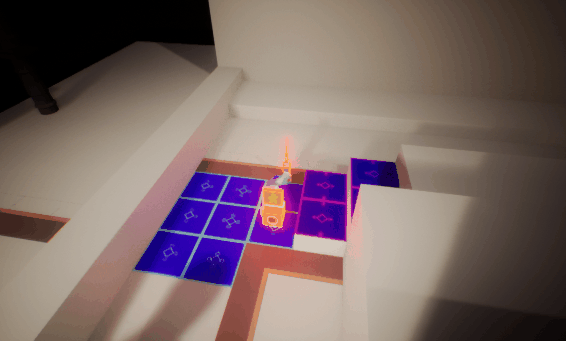Fixing the Pacing - Part 3
During this week I work designing the 6th level where the player is introduced to the ½ tempo tiles. Also, I finished some aspects missing from previous levels like enemy placement and made some changes to facilitate playtest in the future.
Communicating to the player what the ½ tempo tiles do has always been an issue for us. For most people it has taken a while, sometimes even more than 1 level to understand it. To avoid that I took all the parts that we saw working to communicate how it works, and used it to make a cohesive tutorial. First the player starts in a narrow hallway with the only point of interest being the ½ tempo tiles and an enemy on a parallel but separate road. The player can see how the enemy speeds up when walking on these tiles, which communicates that there is something special about them. Next the player will have to pass through a set of these tiles where they can try to imitate the enemy if they want. On the final part of the initial section there is a door/button combo that can only be accessed by walking on more ½ tempo tiles. Also, there is an enemy walking in circles also speeding up thanks to the new tiles. With this we reinforce the idea that the ½ tempo tiles allow those who walk on them to move faster, also due to the urgency of avoiding the enemy most players might attempt to move quicker to avoid them. Still, this challenge is not really that hard as the button is reachable in one movement and the door in 2. The objective is to create a sense of urgency without really putting the player in danger.
The next section serves to motivate exploration, give more space to practice walking on the new tiles and the first real challenge moving on the new tiles. The exploration is promoted by showing a HP collectible that can’t be reached at the moment. The space to practice the ½ tempo tiles is composed of a curved hallway that is safe to move on and has different configurations of tile placements to make it interesting to move. Finally, the 1st real challenge is composed of the enemy the player saw at the beginning and the narrow hallway they are walking on. Now the player has context to understand how he is moving that fast and has the knowledge to also take advantage of the tiles as well.
After the challenge there is a transitional section to process all the player has learned so far, and to keep it interesting the orientation of this long road is horizontal in contrast to the previous vertical roads of the last 2 sections. On this road the player can relax and pay attention to the nice vista in the background.
The next section is composed of 4 “rooms”, one center room that connects the other 3 , one with the exit of the level, one that contains the HP Collectable tha player saw before and one with the button to open the door to the exit of the level. The center room is small meaning that shortly after entering it, the player can see the door blocking the exit and its button. This gives the player their last clear objective. Also, it is likely that the player remembers the missing collectible and wants to grab it to get extra health before the challenge they are likely expecting in the road to the button or they just want it for completion sake. Even if they don’t remember or didn’t see it, the area still causes intrigue as there has not been any empty area so far. This way I create the motivation to explore all the last areas, and what determines how the player tackles them is their personal priorities.
I think this level wasn’t as hard to design as level 5 because it isn’t as strongly interconnected, and because I have been thinking for a long time how we can explain these tiles better. I knew This level had to have a streamlined start to allow the player to focus on the elements that explain how the ½ tempo tiles work, this limited how much the start or middle of the level can connect to the later sections. This comes to prove again that limitations breed creativity.






